Hydraulic presses for crimping cable lugs
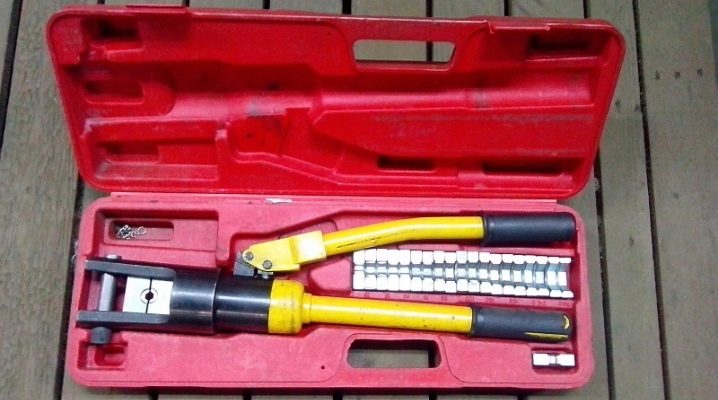
Correct crimping of cables helps not only to make a reliable connection, but also excludes possible overheating of the elements under the influence of electric current. This significantly reduces the risk of a short circuit, contact burnout and subsequent fire.
Therefore, the selection and operation of a hydraulic press for crimping cable lugs is a very important and crucial stage in the performance of work. Before you buy and start using a hydraulic press, you should study the detailed instructions and recommendations of specialists.
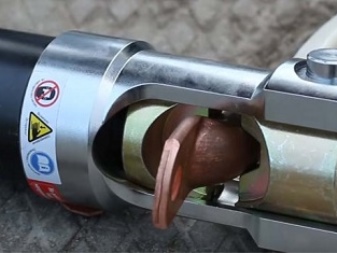
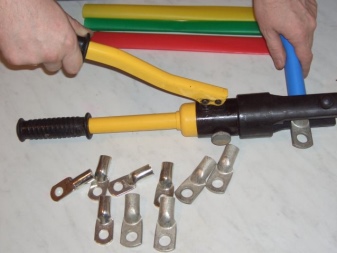
Device and principle of operation
The hydraulic presses for crimping cable lugs (also called crimpers) are based on a special drive mechanism. Its main operational component is 2 cylinders of different diameters, connected to each other by a plastic or steel tube, and movable pistons are installed inside them. For the mechanism to function, its cylinders are filled with oil or other liquid with the same parameters and density.
As in almost all hydraulic equipment, the work of the mechanism of a hand-operated swaging press is built on Pascal's law: the pressure acting on the working fluid (in this case, on a special oil) is uniformly anywhere in its entire area. That is, when a small piston acts (presses) on the working fluid at a certain point, then the pressure, being transmitted or acting on the larger piston, increases sharply.
Accordingly, the pressure force will be the higher, the more the dimensions of the large and small pistons differ.


Views
According to its configuration and method of operation, hydraulic cable crimping pliers are divided into into 3 main types, depending on the type of action of the internal mechanism and its configuration:
- simple;
- double;
- triple.
The listed configurations of the internal device of the press tongs differ from each other in the number of main working elements or organs - special movable partitions.



A simple hydraulic press has 1 movable partition, double and triple action mechanisms - 2 and 3 organs, respectively. The coherence of movements performed by double and triple mechanisms is ensured by separate equipment, the work of which is based on a cyclogram. In addition to the 3 main categories, hydraulic cable crimping presses, or crimpers, are also divided into several types according to the way of use:
- horizontal and vertical devices;
- open and closed instruments;
- hydraulic presses for crimping metal parts (steel wires);
- equipment for crimping elements made of soft material.



Criterias of choice
The choice of equipment will primarily depend on the type of work performed and the material of the processed products. Before purchasing hydraulic press jaws, experts recommend paying special attention to some of the characteristics of the tool.
- The presence of a special built-in valve to control the pressure force. This adjusting piece serves to protect the tool from excessive overload. Both the overall life of the crimper, its development, and the correctness of the operation of its internal mechanisms will largely depend on it.Hydraulic presses that have a pressure relief valve in their design are considered to be more durable and reliable to use.
- Pressing head. In modern hydraulic presses, 2 types of press heads are usually installed: open or closed. Manual hydraulic presses with a closed head type are more difficult to operate and therefore not recommended for home use. A press with a closed head is operated in several stages: first, it is necessary to remove the special retainer and take out the matrix, then fix the cable with the tip in the tool and close the working element, and only then crimp the tip. To crimp in a tool with an open C-shaped head, you just need to open the press, insert the cable and crimp by squeezing the handles.
- Permissible cable cross-section... According to this parameter, hydraulic presses are divided into 4 main types. Hand tools are on sale today with the ability to crimp cables of such diameters - up to 70 mm 2, up to 120 mm 2, up to 300 and up to 400 square meters. mm.
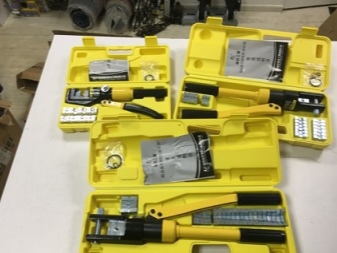

When choosing a hydraulic press for crimping cable lugs, in addition to the main performance characteristics, experts advise paying attention to general technical indicators. For example, it is advisable to take into account the weight of the tool, the material of its manufacture, the shape and length of the handles, the build quality of the device, its brand, country and manufacturing plant.
Chinese-made budget options are more suitable for occasional home use. With frequent use, their mechanisms quickly fail, from heavy loads in the crimper body, breakdowns and leaks of the working fluid are formed.
For frequent use, it is better to choose products of Russian or European production.
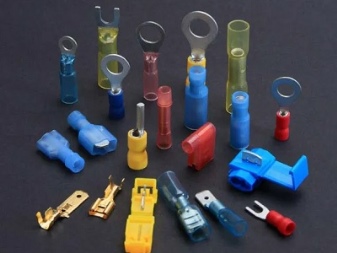
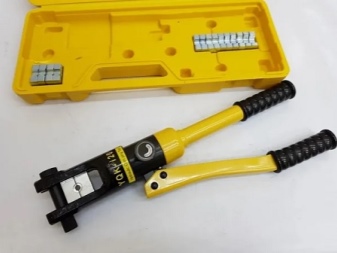
How to use it correctly?
Regardless of the main type and category, hydraulic hand crimping pliers are designed for crimping cable lugs, the cross-sectional area of which ranges from 5 to 400 mm 2. In practice, this device is used, as a rule, only for welding and so-called correct work. Step-by-step instructions for working with a hydraulic crimper for cable lugs:
- install a matrix of the required size (in accordance with the cross-section of the crimped cable) into the seat in the tool stem;
- install the second - a response matrix - in the bore located in the working head of the crimper;
- turn the throttle screw, fixing it in the “closed” position;
- insert the processed material (cable lug) inside the hydraulic press between the dies;
- pressing the movable handle, crimp the material;
- release the pressure of the working fluid by turning the corresponding throttle screw to the "open" position;
- remove the crimped cable lug from the crimper;
- if necessary, remove the formed flash from the crimped tip.



When working with a hydraulic press, it must be borne in mind that a small flash may form on the cable lug during the crimping process. To remove it, it is better to use a file - to grind off with light movements. It is not recommended to try to cut off the flare with a knife or knock it down, as you can damage the integrity of the material, and then the crimping of the tip will turn out to be of poor quality... It is also worth paying attention so that after crimping, too large "ears" do not form on the cable lug, otherwise the crimping procedure will have to be performed from the very beginning. Usually large "ears" are the result of incorrect selection of the matrix.
Sometimes too large "ears" are also cut with a file, if their size allows it.In this case, the main thing is not to overdo it and not to grind off excess material to zero, to the base of the sleeve, since a gap may appear in this place of the cable lug, and the crimp contact will not be strong enough: the material will weaken.
After making sure that the crimping process is performed correctly, at the end of the work it is recommended to insulate the crimping point: at the point between the end of the shank and the remaining free (uninsulated) part of the cable core. A special heat-shrinkable tube is ideal for this.


Five important rules for quality crimping
In addition to the above instructions, when working with a hydraulic press, experts advise adhering to 5 important rules to help you avoid common mistakes and make a high-quality crimp:
- choose the right tip of the right size;
- it is good to strip the metal core of the cable;
- use only specialized tools and auxiliary parts;
- select the right matrix so that the size exactly matches the diameter of the cable;
- do not violate the recommended work order.
















The comment was sent successfully.